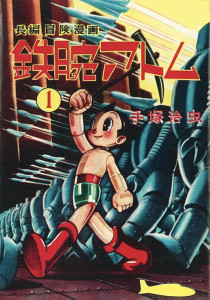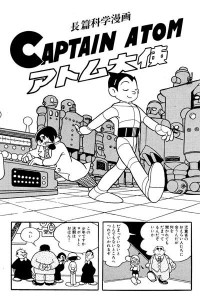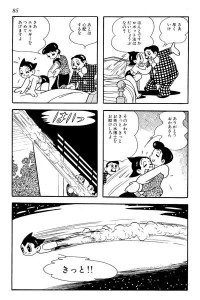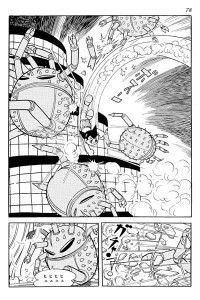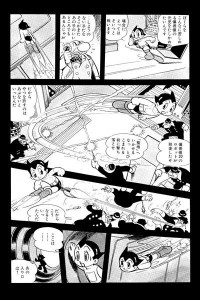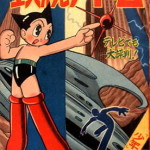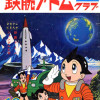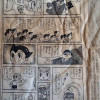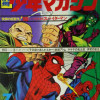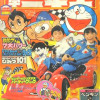Astro Boy [Mighty Atom] (Manga)
Also known as 鉄腕アトム (Tetsuwan Atomu)
| English Title: | Astro Boy |
| In English? | Yes |
| Japanese Title: | 鉄腕アトム Tetsuwan Atomu |
| Type: | Chapter Serial |
| Original run: | 1952/04 – 1968/03 |
| Published in: | Shonen 少年 |
| Published by: | Kobunsha |
| Volumes: | 23 MT-221 | MT-222 | MT-223 MT-224 | MT-225 | MT-226 MT-227 | MT-228 | MT-229 MT-230 | MT-231 | MT-232 MT-233 | MT-234 | MT-235 MT-236 | MT-237 | MT-238 MT-240 | MT-241 | MT-242 MT-251 | MT-252 |
Astro Boy (1952-68), also known as Mighty Atom, is Osamu Tezuka’s beloved story of the boy-robot with 100,000 horsepower. Although the original, long-running, manga series was published in Shonen between April 1952 and March 1968, the manga has also been serialized in the Sankei Newspaper, and published in Mighty Atom Club, Second-Grader, as well as several one-shots and other specials.
The series has also spawned a number of animated television series, feature films, and several video games and other associated works.
What it’s about
Astro Boy (1952-68) is set in the near future, where robotic technology has become so advanced that it is threatening to radically transform human culture. Not only has the loss of many human jobs to robots led to social upheaval, but the robots themselves have become so sophisticated that mankind must begin to recognize them as another sentient species. In Astro Boy (1952-68), Tezuka uses robots as an allegory to explore issues of prejudice and racial intolerance. The robots (and the humans who support them) often face a fierce political and social struggle to secure robot rights against humans who, fearful of change, often offer violent resistance. However, possessing the world’s most sophisticated and human-like computer brain, Astro Boy serves as a bridge between humans and robots, fighting to defend both races and establish peace and friendship between them.
The stories vary in length, and are, for the most part, episodic and self-contained. Many of Astro Boy‘s adventures are simple science-fiction stories; including an expedition to Mars, encounters with aliens, and saving humans from all sorts of dangers. However, amongst these adventures, there are also stories with political overtones, including; Astro Boy protecting the first robot who tries to register to vote, serving as the bodyguard for for world’s first legally elected robot president, or negotiating with robot revolutionaries who are trying to stage a revolt against their human oppressors.
What you should know
Astro Boy (1952-68) is, without a doubt, Tezuka’s most well-known creation. It is also one of the finest examples of Tezuka’s ability to write literature which introduces children to important and serious life issues – with a hero so noble that even those who prefer anti-heroes and charismatic villains find themselves, for once, rooting for the good guy.
The original manga series was one of the big leaps in Tezuka’s overall popularity, and Astro Boy remains to this day, an iconic hero of the Japanese people. Astro Boy’s influence over later manga and anime, both robot stories and science-fiction in general, is immeasurable, and much has been written on his significance as a personification of post-war Japan. Almost single-handedly, he transformed the terrifying force of atomic power into something useful and progressive, helping people to move on from the damage done during the Second World War by getting them to embrace modern technology and look to the future with hope.
However, for one of Osamu Tezuka’s longest-running manga serials, Astro Boy (1952-68) had somewhat humble beginnings.
In October 1950, Osamu Tezuka received a request from the editorial staff at Shonen for a new manga serial which would be titled after the story’s main character. Although Tezuka didn’t yet have a character or a story, he eventually decided on the title “Ambassador Atom” in an attempt to capture the Japanese public’s fascination with then then new science of atomic energy. By February 1951, Shonen was running in-house ads for the new series along with his home address and, after receiving a mountain of fan-mail, Tezuka got to work.
And so, Ambassador Atom (1951-52) (sometimes mistranslated as Captain Atom) was serialized in Shonen between April 1951 and March 1952 – featuring a new, but relatively minor, character known as Astro Boy. Not yet the hero loved by millions, in this story Astro Boy played a supporting role to Tezuka’s regular boy hero, Kenichi.
The basic plot revolves around human beings from Earth coming into contact (and conflict) with look-alike aliens who have been wandering the cosmos in their spaceships after their own earth-like planet exploded. When the two races begin to do battle over scarce natural resources, it’s up to the neutral little robot to mediate the situation.
Although Ambassador Atom (1951-52) wasn’t as successful as Tezuka hoped, the robot Astro Boy seemed to have touched a nerve with his readership. As such, Shonen‘s editor-in-chief, Mr. Takeshi Kanai, explaining that while long-form manga publications might be all about the plot, manga serialized in magazines was driven by the story’s hero, suggested Tezuka make the little robot the star of the story. At Kanai’s urging, Tezuka reworked the robot character, giving him a warmer, more human, personality and turned him into a hero fighting for justice. Astro Boy (1952-68) began serialization in Shonen in April 1952 and would continue for the next 16 years, until March 1968.
While Shonen was the primary home of the Astro Boy manga, from August 1964 to November 1966 stories also began appearing in Mighty Atom Club and from January 1967 until February 1969, in the Sankei Newspaper.
After Shonen suddenly and unexpectedly folded in early 1968, the newspaper serial became the main source of Astro Boy manga – with these adventures sometimes referred to as the Astro Boy Chronicles (1967-69). Although these “second” and “third” Astro Boy manga series were also written by Osamu Tezuka, rather than just continuing the story from the original Shonen serial, they picked up in unusual places – sometimes setting the narrative forward or backward in time by several decades, to explore different moments in the history of human-robot relations.
When the Sankei Newspaper run, too, came to an end almost a year later, Astro Boy chapters began to be published only intermittently through much of the 1970’s – appearing in such publications as Big Comic, Monthly Shonen Magazine, and Monthly Shōnen Jump, among others.
However, in 1980, to coincide with the release of the new animated television show, a new Astro Boy (1980-81) manga series began appearing in Second-Grader, a magazine targeted at young students learning to read. As such, the stories are much simpler, usually short morality tales aimed at a much younger audience than most Astro Boy stories.
In 1986, when Osamu Tezuka decided to return to his most famous manga one more time, he decided to do it as a parody. As such, Atom Cat (1986-87) was published in Smile Comics from July 1986 to February 1987, with the original Astro Boy making several subtle appearances as part of the framing sequences.
Where you can get it
Of course, as Tezuka’s most well-known creation, Astro Boy (1952-68) also happens to also be the one of the longest Tezuka series released in English. Between 2002 and 2004, Dark Horse Comics released a comprehensive 23 volume set, based on the Japanese language Akita Shoten collection – with the stories assembled in Tezuka’s preferred order rather than strictly chronologically. From 2015-17, Dark Horse Comics re-released the series as a 7 volume omnibus edition.
What else you should check out
Check out these pages to find out more details about the original publication dates as well as a short chapter synopsis for the various Astro Boy publications.

